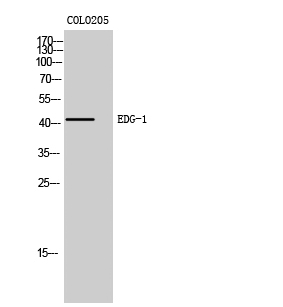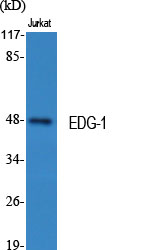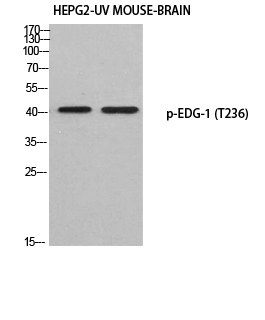
Catalog: KA4272C
Size
Price
Status
Qty.
96well
$330.00
In stock
0
Add to cart


Collected


Collect
Main Information
Reactivity
Human, Mouse, Rat
Applications
ELISA
Conjugate/Modification
Unmodified
Detailed Information
Storage
2-8°C/6 months,Ship by ice bag
Modification
Unmodified
Detection Method
Colorimetric
Related Products
Antigen&Target Information
Gene Name:
S1PR1
show all
Other Name:
Sphingosine 1-phosphate receptor 1 ;
S1P receptor 1 ;
S1P1 ;
Endothelial differentiation G-protein coupled receptor 1 ;
Sphingosine 1-phosphate receptor Edg-1 ;
S1P receptor Edg-1 ;
CD antigen CD363 ;
S1P receptor 1 ;
S1P1 ;
Endothelial differentiation G-protein coupled receptor 1 ;
Sphingosine 1-phosphate receptor Edg-1 ;
S1P receptor Edg-1 ;
CD antigen CD363 ;
show all
Background:
function:Receptor for the lysosphingolipid sphingosine 1-phosphate (S1P). S1P is a bioactive lysophospholipid that elicits diverse physiological effect on most types of cells and tissues. This inducible epithelial cell G-protein-coupled receptor may be involved in the processes that regulate the differentiation of endothelial cells. Seems to be coupled to the G(i) subclass of heteromeric G proteins.,induction:By the tumor promoter phorbol 12-myristate 13-acetate (PME) in the presence of cycloheximide.,PTM:S1P-induced endothelial cell migration requires the PKB/AKT1-mediated phosphorylation of the third intracellular loop at the Thr-236 residue.,similarity:Belongs to the G-protein coupled receptor 1 family.,tissue specificity:Endothelial cells, and to a lesser extent, in vascular smooth muscle cells, fibroblasts, melanocytes, and cells of epithelioid origin.,
show all
Function:
angiogenesis, blood vessel development, vasculature development, regulation of nucleotide metabolic process,regulation of transcription, DNA-dependent, regulation of transcription from RNA polymerase II promoter, cellular ion homeostasis, cellular calcium ion homeostasis, cellular metal ion homeostasis, cell adhesion, cell surface receptor linked signal transduction, G-protein coupled receptor protein signaling pathway, G-protein signaling, coupled to cyclic nucleotide second messenger, G-protein signaling, coupled to cAMP nucleotide second messenger, inhibition of adenylate cyclase activity by G-protein signaling, negative regulation of adenylate cyclase activity, activation of phospholipase C activity by G-protein coupled receptor protein signaling pathway coupled to IP3 second messenger,activation of phospholipase C activity, elevation of cytosolic calcium ion concentration, intracellular signaling cascade,positive regulation of cell proliferation, positive regulation of biosynthetic process, regulation of phospholipase activity,positive regulation of phospholipase activity, positive regulation of macromolecule biosynthetic process, positive regulation of macromolecule metabolic process, positive regulation of gene expression, negative regulation of organelle organization, positive regulation of phospholipase C activity, transmission of nerve impulse, cellular homeostasis, second-messenger-mediated signaling, cAMP-mediated signaling, cyclic-nucleotide-mediated signaling,biological adhesion, cellular cation homeostasis, cellular di-, tri-valent inorganic cation homeostasis, regulation of cell adhesion, neuron differentiation, regulation of cell migration, positive regulation of cell migration, regulation of cyclic nucleotide metabolic process, regulation of cyclic nucleotide biosynthetic process, regulation of nucleotide biosynthetic process, regulation of cAMP metabolic process, regulation of cAMP biosynthetic process, epithelial cell differentiation,regulation of cyclase activity, negative regulation of cyclase activity, positive regulation of cellular biosynthetic process,regulation of response to external stimulus, positive regulation of response to external stimulus, regulation of actin filament bundle formation, negative regulation of actin filament bundle formation, regulation of Ras GTPase activity,positive regulation of Ras GTPase activity, regulation of actin cytoskeleton organization, regulation of actin filament-based process, regulation of organelle organization, regulation of locomotion, positive regulation of locomotion,regulation of cell proliferation, homeostatic process, positive regulation of catalytic activity, negative regulation of catalytic activity, regulation of GTPase activity, positive regulation of GTPase activity, regulation of cellular component biogenesis, negative regulation of molecular function, positive regulation of molecular function, endothelial cell differentiation, regulation of transcription, regulation of adenylate cyclase activity, positive regulation of transcription, DNA-dependent, positive regulation of nucleobase, nucleoside, nucleotide and nucleic acid metabolic process, positive regulation of transcription, positive regulation of transcription from RNA polymerase II promoter, regulation of Ras protein signal transduction, phosphoinositide-mediated signaling, blood vessel morphogenesis, positive regulation of behavior, positive regulation of response to stimulus, regulation of smooth muscle cell proliferation, positive regulation of smooth muscle cell proliferation, chemical homeostasis, regulation of behavior, ion homeostasis, neurological system process, regulation of chemotaxis, positive regulation of chemotaxis, regulation of positive chemotaxis,positive regulation of positive chemotaxis, regulation of small GTPase mediated signal transduction, negative regulation of cellular component organization, positive regulation of nitrogen compound metabolic process, regulation of RNA metabolic process, positive regulation of RNA metabolic process, regulation of cell motion, positive regulation of cell motion, regulation of hydrolase activity, regulation of lyase activity, positive regulation of hydrolase activity,negative regulation of lyase activity, cytosolic calcium ion homeostasis, elevation of cytosolic calcium ion concentration during G-protein signaling, coupled to IP3 second messenger (phospholipase C activating), regulation of stress fiber formation, regulation of cytoskeleton organization, negative regulation of cytoskeleton organization, negative regulation of stress fiber formation, metal ion homeostasis, di-, tri-valent inorganic cation homeostasis, calcium ion homeostasis, cation homeostasis, cellular chemical homeostasis, regulation of lipase activity, positive regulation of lipase activity, epithelium development,
show all
Cellular Localization:
Cell membrane ; Multi-pass membrane protein. Endosome. Membrane raft. Recruited to caveolin-enriched plasma membrane microdomains in response to oxidized 1-palmitoyl-2-arachidonoyl-sn-glycero-3-phosphocholine. Ligand binding leads to receptor internalization.
show all
Signaling Pathway
Reference Citation({{totalcount}})
Catalog: KA4272C
Size
Price
Status
Qty.
96well
$330.00
In stock
0
Add to cart


Collected


Collect
Recently Viewed Products
Clear allPRODUCTS
CUSTOMIZED
ABOUT US
Toggle night Mode
{{pinfoXq.title || ''}}
Catalog: {{pinfoXq.catalog || ''}}
Filter:
All
{{item.name}}
{{pinfo.title}}
-{{pinfo.catalog}}
Main Information
Target
{{pinfo.target}}
Reactivity
{{pinfo.react}}
Applications
{{pinfo.applicat}}
Conjugate/Modification
{{pinfo.coupling}}/{{pinfo.modific}}
MW (kDa)
{{pinfo.mwcalc}}
Host Species
{{pinfo.hostspec}}
Isotype
{{pinfo.isotype}}
Product {{index}}/{{pcount}}
Prev
Next
{{pvTitle}}
Scroll wheel zooms the picture
{{pvDescr}}



















